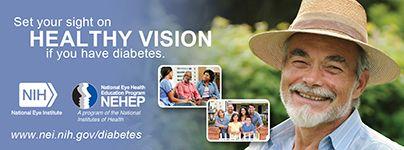This content is also available in:
Español (Spanish)
 Set Your Sight on Healthy Vision If You Have Diabetes
Set Your Sight on Healthy Vision If You Have Diabetes
Diabetic retinopathy is the leading cause of new cases of blindness and low vision in adults aged 20-65. Retinopathy is a term that describes damage to the retina of the eye. Diabetic retinopathy is the result of high blood sugar due to diabetes. Some of the symptoms of this condition are:
- Blurry vision or double vision
- Flashing lights, which can indicate a retinal detachment
- A veil, cloud, or streaks of red in the field of vision, or dark or floating spots in one or both eyes, can indicate bleeding
- Blind or blank spots in the field of vision
Managing Diabetes
People with diabetes need to understand how to manage their diabetes, including the tools and strategies they can use. Too often, the diabetes education, low vision, and vision rehabilitation fields do not connect. Thus, people with diabetes and low vision often lack the information and resources to manage their diabetes effectively. This situation can lead to a number of unintended health consequences. APH VisionAware fills the void by providing diabetes management information, including the following topics:
- Monitoring diabetes and blood glucose levels, including testing these levels safely and accurately
- Taking insulin or other diabetes medications accurately
- Eating healthily and following the ADCES7 Self-Care Behaviors, adapted for people with blindness or low vision
Webinar: “Meeting the Diabetes Management Needs of Older People with Vision Loss”
Sharing this critical information with Chronic Disease Management programs, rehabilitation and aging professionals, and consumers is essential. To that end, APH VisionAware offered a webinar at the National Council on Aging’s Age + Action virtual conference to address these audiences. We are happy to be able to share the link to the webinar entitled “Meeting the Diabetes Management Needs of Older People with Vision Loss.” There is no cost, but you must register to listen to it. Presenters included Diabetes Educator Kim Ladd, RN, BS, CPHQ, CDCES; Neva Fairchild, MS; Katie Frederick, CPACC; and Pris Rogers, Ph.D.
Diabetes Educator Kim Ladd demonstrated how people with diabetes and low vision can test blood sugar levels safely and accurately. She also discussed strategies for taking medications safely with blindness or low vision, including using accessible devices. Presenters also covered how these strategies can be incorporated into existing and new chronic disease management programs to maximize inclusiveness.
During the webinar, the presenters highlighted the diabetes resources and information in English and Spanish on the APH VisionAware and through archived webinars on diabetes. (See #’s: 21,36,38,39,69). Additionally, they showcased the APH national directory of vision rehabilitation services and how to access and utilize these vital services.
Free Style Libre 2
As part of the session, Neva Fairchild discussed her experience with the Free Style Libre 2. For this post, she has provided an update of what she shared: “Free Style Libre 2 has low and high blood sugar alarms built in. If your blood sugar drops below 70, it sounds like an alarm on your phone. If it continues to fall to 55, there is an urgent alert. Conversely, you are alerted if your blood sugar rises to 240. These settings can be changed if your doctor chooses different levels for you, and you still must scan the sensor to be sure what your blood sugar level is when the alarm sounds. This feature will help with learning how your body reacts to what you eat and do so that you can better control your diabetes.”
Read More About NEI Resources and Low Vision Awareness Month
APH VisionAware partners with the National Eye Institute to bring awareness to resources that help consumers, family members, and professionals learn about the importance of vision rehabilitation services.
Low Vision Awareness Month
Professional vision rehabilitation information
Consumer vision rehabilitation